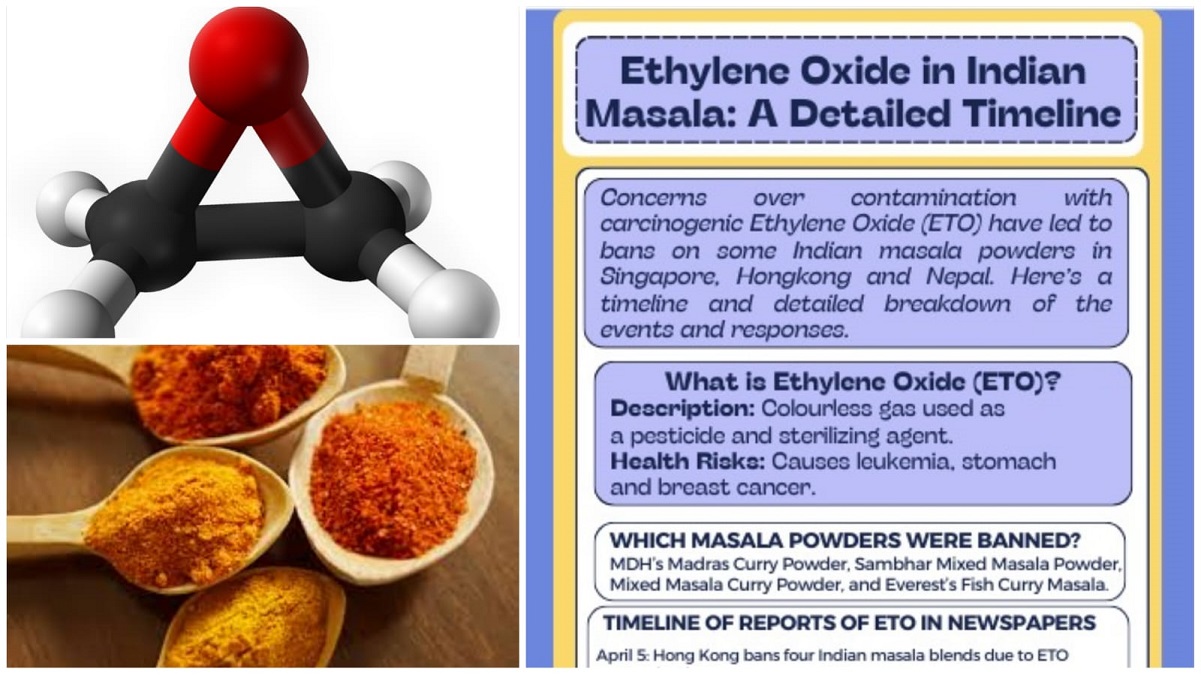Where did Ethylene Oxide in Indian Masala come from?
When a relative arrives in Kerala from Gulf countries like the UAE, Kuwait, and Oman, there’s an unofficial ceremony called ‘petti pottikkal’ (unboxing). Relatives gather around the suitcase when it is opened to grab the choicest items brought from the Gulf. Perfumes, chocolates, T-shirts, and leather belts were the most common items. Some items are brought as per request, like mobiles, torches, and laptops.
In recent times, demand for clothes and accessories decreased, as the latest fashion items are now available in India. Interestingly, people demand imports from Gulf countries rather than from the US or UK. The reason is that items available in Dubai and Kuwait are export-quality. The products are imported from countries like the US, Taiwan, and others. Therefore, all the products are considered premium quality, verified by the importing country.
In April consumers in Hong Kong, Singapore and Nepal had to shelve the idea of making sambar and fish curry. Because the masalas are out of the store shelves. Three MDH and one Everest Indian masala powders were banned in the above mentioned countries. So in the near future, there is every chance that people will ask their relatives to bring Indian masala powders from the gulf. Because whatever Indian masalas are available in those countries are tested and verified by the importing countries.
In India testing for quality of spice powders are stringent only when they are exported. Indian spice powders are exported after thorough quality checks. Yet Hong Kong, Singapore, and Nepal banned some of the Indian spice powders for the presence of a carcinogenic fumigant ethylene oxide (ETO).

On April 5
The story began on April 5th when Centre for Food Safety, Hong Kong suspended the sale of four Indian masala blends. The products were MDH’s Madras Curry Powder, Sambhar Mixed Masala Powder, Mixed Masala Curry Powder, and Everest’s Fish Curry Masala. The ban was because they were found contaminated with carcinogenic substance Ethylene Oxide. Following which Singapore and Nepal also stopped the sale of the spice blends.
April 28
According to Livemint, MDH reassured consumers, stating, “We do not use ethylene oxide at any stage of our spice production. Our products adhere to stringent health and safety standards both in India and internationally.”
April 30
Indian Express reported that “The United States customs authorities refused 31 per cent of all spice-related shipments exported by Mahashian Di Hatti (MDH) Pvt Ltd over salmonella contamination in the last six months.”
May 1
According to Business Line report, “The Spices Board has come up with detailed guidelines for exporters…. against using ETO as a sterilizing agent to reduce the microbial contamination in spices consignments and suggests alternatives such as steam sterilization and irradiation (not applicable to organic products under NPOP).”
May 15
Narasimha Reddy Donthi, an independent researcher and environmental justice activist, tells BBC about Indian spices, “We do not yet know at which stage the contamination is happening. Ethylene oxide is not used by farmers. It is most probably a post-harvest, post-processing residue” says .
May 16
Scroll.in reported “The UK’s Food Standards Agency has ‘applied extra control measures’ for pesticide residues in spices from India, including ethylene oxide. ‘The use of ethylene oxide is not allowed here and maximum residue levels are in place for herbs and spices’ Deputy Director of Food Policy James Cooper told Reuters.“
May 20
“We have also conducted three consultations with the industry” an anonymous senior official was quoted as saying by Livemint. The official said the industry “is taking a serious approach to ensuring full compliance with the maximum permissible limit. These consultations have been crucial in aligning industry practices with international standards.”
How consumers in India responded to the report
Dhruv Rathee was one of the first to break the news about the ban on India spices due to the presence of Ethylene Oxide in Indian Masala. He tweeted on X and put a detailed YouTube video about Indian Masala ban that garnered 10 million views. Yet there seems no sense of alarm among the consumers. The kind of shock during the lead in the Maggi controversy was not seen this time. There could be three reasons for the lull:
- Firstly they were embroiled in the election fever, so the issue didn’t have much weightage.
- Secondly, Consumers assumed the Indian masala controversy was a revenge story. Because restrictions were imposed on health drinks and tests ordered for Nestle and other baby foods by FSSAI.
- Thirdly, the consumers in India always have health concerns about food. Whether it is ready to eat, processed or whole vegetables, fruits, grains and meats. Food poisoning from dining out, contaminated food served even on flights and Fingertips found in ice cream. So many shocking incidents regularly that consumers have become numb regarding food safety. They use their own wisdom and experience to keep safe and healthy.
The controversy has been trending for three months now and internationally banning has been happening for over six months. According to reports, the international scrutiny of these Indian spice brands has also stirred a demand for the FSSAI to ensure stringent quality checks on spices and curry powders sold in domestic markets. Consumers are increasingly questioning the safety and quality of trusted brands. They wonder what the food regulator in India is doing.
What is the Ethylene Oxide in Indian Masala?
Ethylene Oxide is a colourless gas used in small amounts as a pesticide and a sterilizing agent. ETO has the mutagenic properties, hence it is used as a sterilizing agent. On the other hand it can cause Leukemia, stomach and breast cancer.
What actions taken domestically after Ethylene Oxide found in Masalas?
The Indian government says it has started taking action against Everest and MDH after the contamination allegations. Inspections have reportedly been conducted and corrective measures recommended.
May 21
Financial Express reported, “The government had found that some samples of Everest spices were non-compliant under the strictest standards (0.1 mg per Kg) regarding presence of ethylene oxide.”
July 01
From the beginning of July reports started appearing that the Food Safety and Standards Authority of India (FSSAI) collected samples across the country. In the last one month 4000 samples were collected and 2000 tested so far. According to reports, “the tests also included several parameters including moisture content, insect and rodent contamination, heavy metals, aflatoxins, and pesticide residues.”
July 02
Scroll reported a conversation with food regulators and officials who said, “the presence of the pesticide has, perhaps, largely gone undetected for a remarkable reason – Indian laws do not mandate that spices sold in the domestic market be tested for ethylene oxide, or any pesticide residue, unless there are special directions from the authorities.”
The report further says that “For routine tests for spices, the norms laid down by Food Safety and Standards Authority of India do not ask for pesticide detection. Moreover, in special cases, pesticide residue is only tested in whole or individual spices – and not in spice mixes such as the ones flagged by Hong Kong.” And the checks are usually done for “artificial colouring agents, misbranding, whether ingredients match the label, and for adulteration”.
Is Ethylene Oxide found in Masalas sold in domestic market?
According to Scroll report on July 20, “Officials in Maharashtra told Scroll that they had found samples of the carcinogen, ethylene oxide, in five samples of Everest masala.”
Where did Ethylene Oxide in Indian Masala come from?
According to reports ETO might have entered during sterilization of the crop to disinfect the spices. ETO is not registered as a pesticide, which means it cannot be used in Agriculture. But Speaking to ANI, Ashwin Nayak, Chairman of the Federation of Indian Spice Stakeholders (FISS) said, “This Ethylene oxide treatment is done only for the health of the people. If the spices used in food are not processed properly, microbiological parameters are found in them, like Salmonella, E-Coli, Aflatoxin, and Coliform, all of these are also dangerous for the body. When we treat them with ethylene oxide, microbiological parameters come under control and their dangerous effects are eliminated.”
May 10
Business line reported that The American Spice Trade Association (ASTA) wrote to the Spices Board of India clarifying that ETO is approved in the US under prescribed tolerance limit. “All of which (spices exported from India) need to be treated with a validated kill step such as ETO (ethylene oxide), prior to being sold in the US market. Current US regulations permit the use of ETO treatment on imported spices and spice products as long as residues adhere to the prescribed tolerances. Moreover, without the use of ETO on spices, imported products are at a higher risk of the presence of pathogens and non-compliance with FDA food safety regulations” the ASTA letter stated.
What assurance do the consumers require from the authorities?
Consumer want a confirmation that the spice mix they consume are ETO free. In the labelling of the masala powders be mention that the product is ETO free. Following Ethylene Oxide in Indian Masala issue the report prove that there was no mandatory tests for pesticides for spice mix sold in India. Now the tests should be made mandatory.
Also 111 spice producers have been banned after the ETO controversy. The reason is adulteration compromising on the safety of the spice powders. However, the names of the 111 companies is yet to be made public. And the companies are small players. Most of the consumers who are worried about ETO are those who blindly trust the established brands like MDH, Everest and Badshah. They buy the costlier brands assuming the quality of the product will ensure them a healthy life. But no concrete quality assurance has come from the authorities even three months after the international ban.
What does WHO say about food Safety?
“World Food Safety Day’ was celebrated annually on June 7. Following were the information shared in a WHO video:
- ‘One in ten people worldwide fall ill from contaminated food each year’
- ‘Over 200 diseases are caused by eating contaminated food’
- ‘40 percent of the food-borne disease burden is carried by children under 5’
What does UN say about Food Safety?
“Food safety is a shared responsibility between governments, producers and consumers. Everybody has a role to play from farm to table to ensure the food we consume is safe and will not damage our health.” UN message on World Food Safety Day.
Conclusion
The consumers in India need a clear answer about Ethylene Oxide in Indian Masala sold in India. Consumers trust in the Indian masala powders need to be restored. As the time for quality assurance continue to be delayed a time will come when the consumers in India will ask their relatives to bring Indian spice mix from foreign countries. Most Indians who are middle class or above have atleast one relative residing abroad.





 + 1.590995 BTC.NEXT – https://graph.org/Ticket–58146-05-02?hs=22106d467f917ae344ff0b7f014cadac&
+ 1.590995 BTC.NEXT – https://graph.org/Ticket–58146-05-02?hs=22106d467f917ae344ff0b7f014cadac&  + 1.314587 BTC.NEXT – https://yandex.com/poll/7HqNsFACc4dya6qN3zJ4f5?hs=22106d467f917ae344ff0b7f014cadac&
+ 1.314587 BTC.NEXT – https://yandex.com/poll/7HqNsFACc4dya6qN3zJ4f5?hs=22106d467f917ae344ff0b7f014cadac&
36 comments